Your most compelling personal brand story is found in your simple scenes
You can listen to this article and gain more resources here:
Do you ever get cotton-mouth when you speak? Nerves set in. Your armpits seem to suck all the moisture out of your mouth?
It recently happened to me.
I was the last of six TEDx presenters at TEDxGilbert on March 24, 2018. The theme we spoke to was Identity: Who We Are and Where We’re Going. It was a standing-room-only crowd in the University Center theater in Gilbert, AZ. The place was a sauna when I stepped on the stage at 9 pm.
My piehole was parched.
About one minute into my presentation the plumbing department to my mouth experienced a shutdown. TED organizers don’t like you packing around water on the stage, so I had to forge on as my tongue became carpet.
But then I remembered a trick our master of ceremonies, Rachael Mann, had shared with us earlier in the day. When your mouth feels like it’s wallpapered with Saltine crackers, imagine sucking on a lemon drop.
I carved out a section of my brain to picture that sour sucker without missing a beat in my presentation. My saliva sprinkler system kicked back on to rehydrate my gummy gums.
Try it. Picture yourself sucking on a lemon drop right now.
Wait for it….
What just happened in your mouth?
Such is the power of story. Even making up a fictional narrative of a tart candy tricks your mind into thinking you’re actually experiencing it and your body responds.
How to be the best and boldest nonfictional you
The lemon drop experiment is not only a lifesaver for cotton-mouth, it’s also a savory example of how stories transport us. From Saltines to lemon drops, your mind lives vicariously through the telling.
But the problem is that we often live into the wrong story we tell ourselves through our personal narratives. We live into fiction.
We are so busy living up to what we believe other people think about us that we don’t remain true to our own authentic story. Social media fuels this fake world as we all try to keep up with the Joneses by posting perfectly coifed images of our beach vacations, envious gatherings and for whatever reason, the coconut encrusted Mahi Mahi plate we had for lunch.
This was the TEDx topic I explored: In this fictional world, how can we be our best nonfictional selves even when we think our audiences expect an epic adventure out of us?
So I asked the audience to stop looking for their heroic stories, but start finding their scenes: those seemingly insignificant moments that have shaped who they are today. Find your scenes and your story will find you.
How to frame your authentic story
I consult, teach, coach and speak on the power of story for personal, professional and organizational branding. But like Dr. Vo, my dentist who doesn’t perform his own root canals, I needed help extracting my TEDx presentation from my cluttered mind.
So I turned to Tamsen Webster, a brilliant presentation coach who has her own approach to storytelling she calls the Red Thread Method. Tamsen is also the producer of TEDxCambridge, so she knows the TED stage well.
Her coaching was invaluable to help me frame my message. I’ve learned from my own story workshops that we get so close to our individual narrative that it is difficult to find our theme without the clear vision of others. Plus, working with another story wizard helped me appreciate that this story stuff is difficult without the proper guidance.
For instance, here’s what the initial elements of my TEDx talk looked like in Tamsen’s Red Thread Method. When I showed it to her during one of our ZOOM sessions, she giggled an empathetic “OMG, I know, story is hard.”
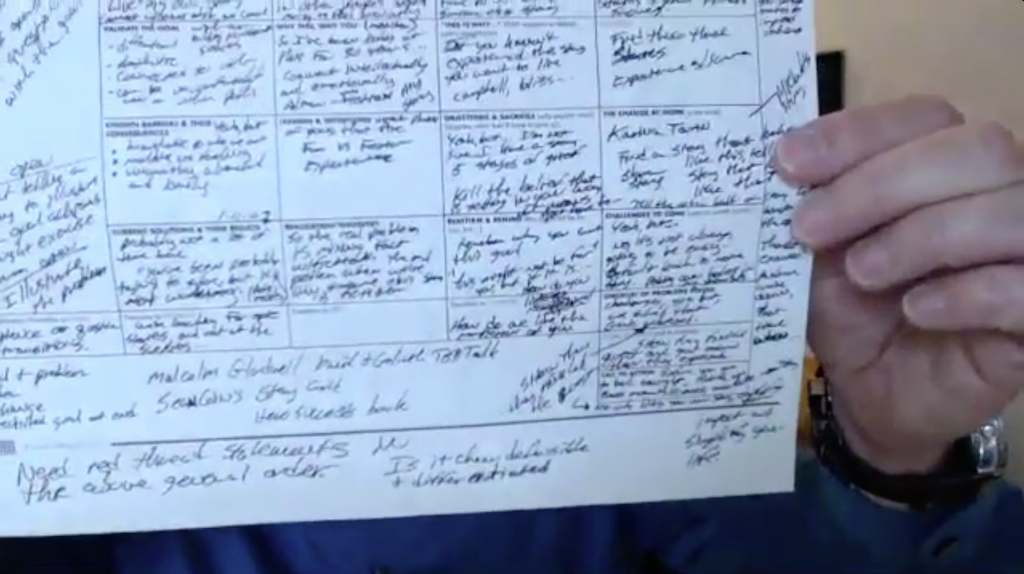
Then I struggled to weave my theme throughout the presentation. When I thought I had finally arrived with my script I sent it to Jen Dille, the producer of TEDxGilbert. But it didn’t pass muster.
Jen said that she liked my big idea but that my message wasn’t clearly communicated. Talking about taking a quill pen to the heart of a storyteller. Ugh! Mrs. Pintler, my fourth grade English teacher, immediately popped to mind giving me a fat red F on a paper I worked hard on. So, with just two weeks to go before TEDxGilbert, I tossed my first attempt and started over.
Relying on the applied science and bewitchery of story
I went back to my Red Thread blueprint and ruthlessly edited. But I was lucky. As I searched for the connective tissue in my narrative, the universe delivered a few choice insights and stories in my hour of need that are now reflected in my presentation.
For instance, Anjella’s story presented itself during a Business of Story workshop I delivered to Silverline Sales Force Solutions just prior to TEDxGilbert. Her story, which you can hear at the 5:30 mark in my talk, is the ideal example to demonstrate the premise of my presentation.
I’ve learned that when you are following your true story that the universe will deliver in your time of need. The trick is to be paying attention and recognize the gifts when they arrive.
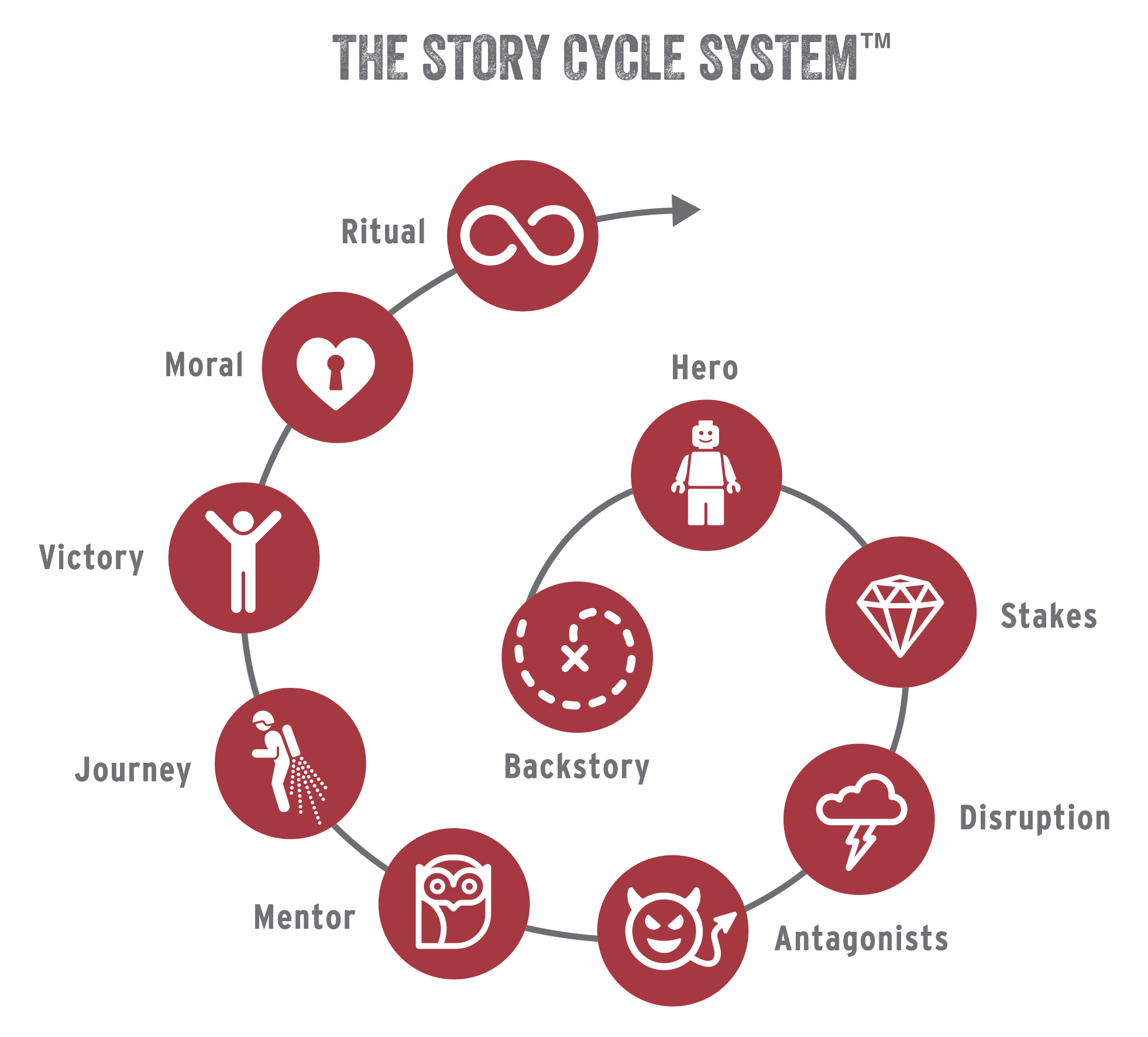
The Spiral Narrative Structure Capture in the Story Cycle System to Increase Customer Engagement With Every Rotation
While the Red Thread helped me frame my message and outline the ebb and flow of my presentation, I returned to a story framework that I was more familiar with to put the final touches on my speech: the Story Cycle System.
Similar to the Red Thread Method, the Story Cycle is based on a proven story structure. Like so many, I was inspired by Joseph Campbell’s Hero’s Journey, which is the basis for the Story Cycle.
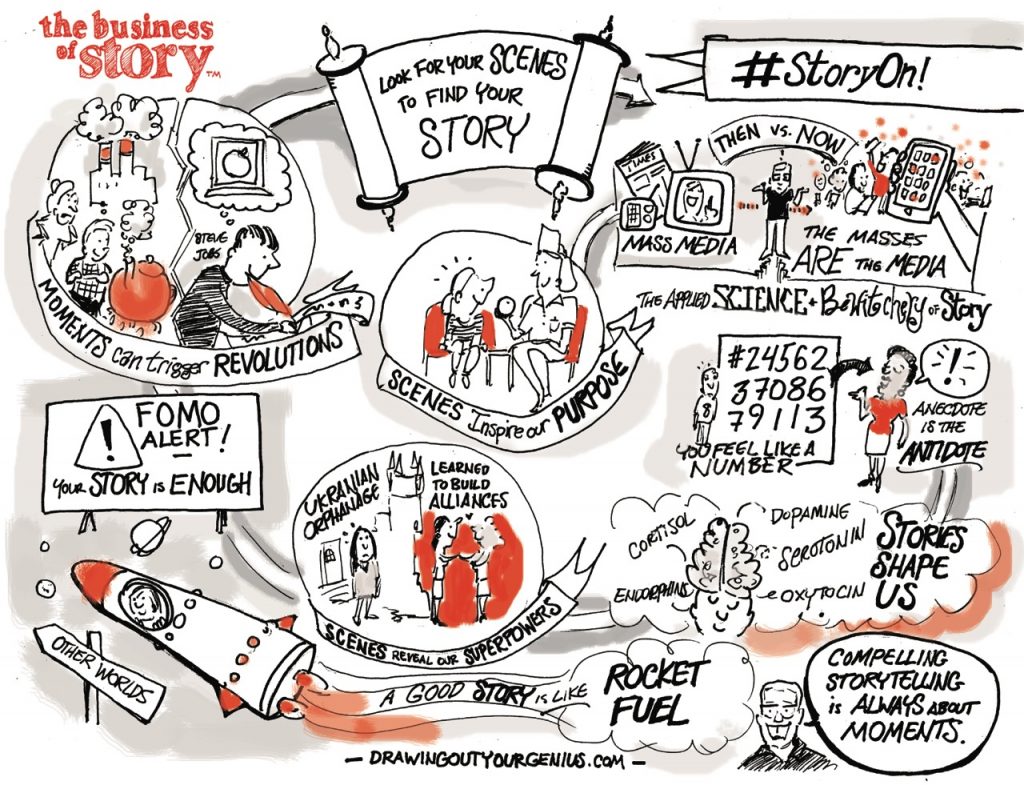
While Tamsen helped me frame my presentation, and her Red Thread Method was essential to get my head around my TEDx Talk, I used my Story Cycle to guide me through its final creation. I even had artist Lisa Rothstein of drawingoutyourgenius.com illustrate my talk for three reasons:
- Help me visually memorize my presentation
- Illustrate the Story Cycle spiral in action
- Demonstrate how to string together scenes through anecdotes that create your overall story
Here’s how my TEDxGilbert script works within the 10-step Story Cycle System:
STEP 1: BACKSTORY – You set the stage for your premise to generate curiosity in your audience
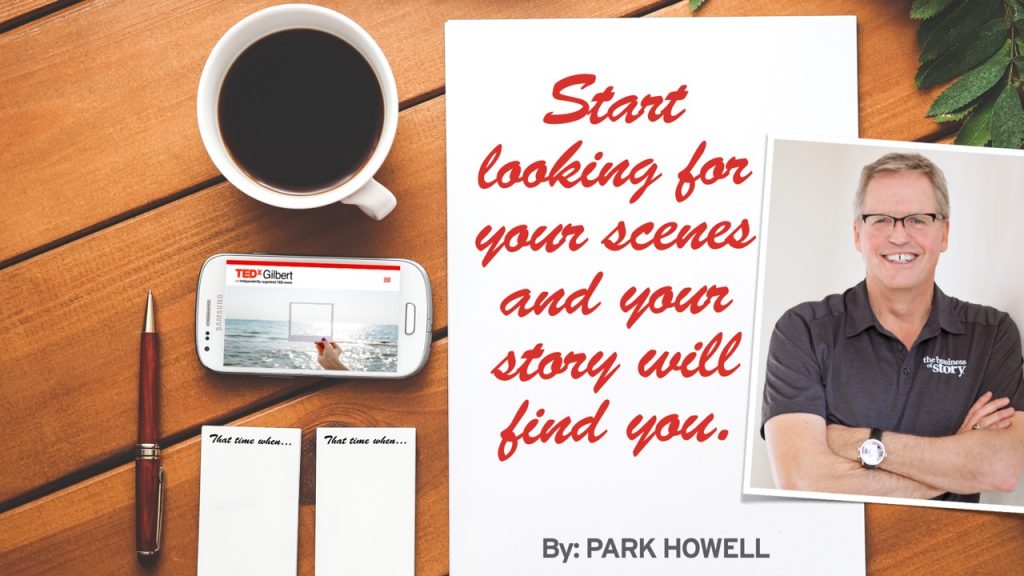
I know an amazing lady who will celebrate her 93rd birthday on April 5th. When she was just four years old, Pat was sitting in a strange and cold waiting room in a hospital in Wenatchee, Washington. She was eager for the arrival of her new baby sister, Diane, but the surroundings kind of creeped her out.
Then out of nowhere, this nurse shows up, dressed in her nurse-whites, like a guardian angel. She chatted with the little girl to set her at ease and then gave her an orange.
Pat never forgot the kindness of that complete stranger. In fact, because of it, she became a nurse after World War II. Got married at 29, had seven kids in nine years. And if you ever wondered if God has a sense of humor, he put HER in charge of starting the sex ed. program at her children’s school: St. Brendan’s in Bothell, Washington.
After her brood had grown, she volunteered for nearly three decades at Overlake Hospital in Bellevue, until her mid-80’s. Most recently, she has been caring for her husband who is battling Alzheimer’s.
Just imagine all of the people she has helped over the past 70 years because, as she told me, that seemingly insignificant moment in a waiting room, a thoughtful nurse and the warmth she bestowed, through the symbolism of an orange.
STEP 2: HERO – Connect your idea to your audience from their point-of-view as you make them the center of your story

Do you know what your true calling is? As Pat showed, you don’t need to craft some epic tale about love and loss to find it. Instead, look for the simple scenes that set everything in motion for you…those small moments that have shaped who you are today.
STEP 3: STAKES – Define what is at stake for your audience relative to your theme to increase its importance
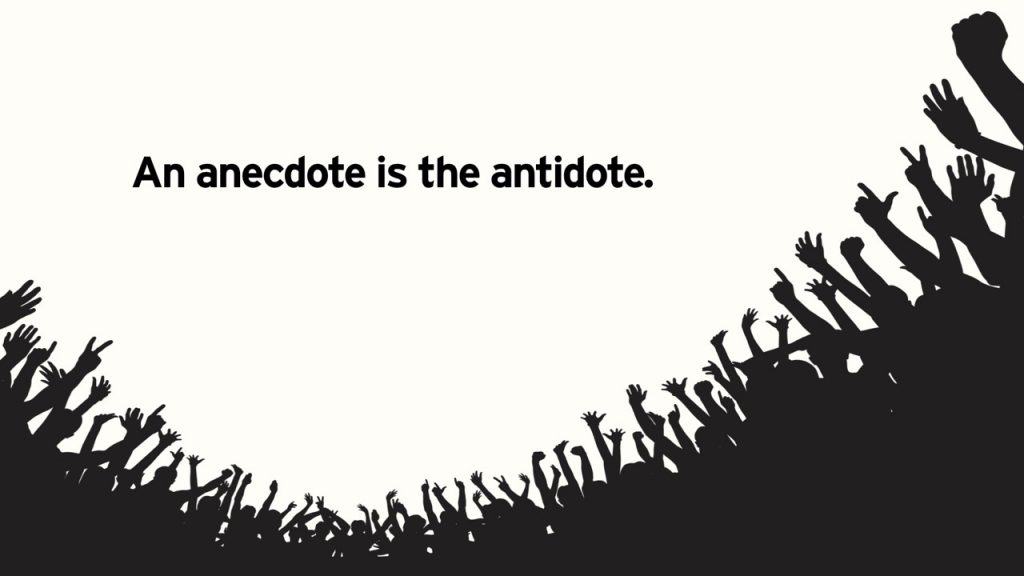
I started to realize just how important scenes are in our lives when, in 2006, I began studying the applied science and bewitchery of storytelling.
I had been in branding and marketing for over 20 years and I watched as the advertising paradigm as we knew it was falling apart. Brands used to own the influence of mass media, but the masses had become the media, and it got difficult to rise above the noise, stand out and be heard.
So I went looking for the answer.
I discovered an anecdote is the antidote.
“The human mind yields helplessly to the suction of story,” says Jonathan Gottschall, author of The Storytelling Animal: Why Stories Make Us Human. We’ve used storytelling as our most powerful survival tool to evolve from cavemen to consumers.
I believe it because I’ve experienced the magic of being a storytelling ape.
Science is revealing how stories shape us. Functional brain scans show that when we consume a story, the region of our brain called the left temporal cortex lights up, thinking we are actually playing a role in that story.
Blood tests show that good stories can trigger five neurotransmitters that make us experience what the protagonist is experiencing. These include serotonin, dopamine, oxytocin, cortisol and endorphins.
For instance, when I was invited to speak at this TEDx event, I was pretty pumped. My mind was flooded with serotonin because I felt wanted and important. This made me happy.
Then I got excited about the task of finding my big idea and anticipating the rewards of sharing my experiences with you. This triggered dopamine providing me with optimism and delight.
Recalling and writing the stories within this talk has released within me oxytocin, the drug that creates understanding, empathy and connection.
When I experienced the crisis of being told that my final draft needed work…lots of work… my cortisol pump fired up providing the focus I needed.
And when I had to burn the midnight oil because time was running out, endorphins kicked in for endurance, summoning my second wind and delivering the euphoria of overcoming this challenge.
Know these feelings?
Ira Glass, host of This American Life, who draws 1.7 million listeners every week to his stories, said “The power of anecdote is so great that it has a momentum all its own.” He contends, “No matter how boring the facts are, with a well-told story you feel like you’re on a train that has a destination.”
No wonder we call it the “Theater of the mind.”
Stories shape who we are individually and collectively. But be careful. Because when we hear them on the “Ira Glass scale,” we’re tempted to think that our stories don’t measure up, …even as our over-communicated world implores you to tell your story.
STEP 4: DISRUPTION – Restate your idea and illustrate why it is more urgent now than ever through a true story

I say forget your story and locate YOUR scenes first: those moments that have shaped who you are today, which created your superpower.
Your story will then find you.
Let me give you an example: Two weeks ago I met Anjella Crowe, a soft-spoken, thirty-something Ukrainian immigrant. She works for a fast-growing, high-tech Customer Relationship Management firm in New York. I was doing a Story Cycle workshop with 50 of their top sales and marketing people when Anjella volunteered to tell her story.
She said that her sole-purpose at the company is to build important alliances and partnerships within the organization and its customers.
That was all fine and dandy, but when I pressed her to recall the specific moment when she knew this was her superpower, she pushed back. Perhaps it was because we were working her story in front of her colleagues. Maybe it was too painful of a moment to share in public.
After the session, she came up to me and said, “I didn’t tell you everything.”
“I know. How come?” I asked.
“I’ve been told that business people wouldn’t think it is appropriate to talk about my hard times in the orphanage.”
“Orphanage? Wait a sec….You grew up in a Ukrainian orphanage!?” I asked.
“Yes, since birth until I was 18. It was hard. People picked on me and abused me, so I don’t talk about it. I’m told no one wants to hear it,” she said.
“How’d you cope?”
She recalled the moment when she realized she had to surround herself with kids she could trust and with adults who didn’t just care for her, but about her. Anjella built groups of these people to help her rise above the conditions.
“OMG, No wonder you excel at building alliances and partnerships, I said. You grew up doing it to survive.”
I encouraged Anjella to absolutely talk about her life in the orphanage without having to go into all of the difficult details.
I mean, come on, “Ukrainian orphanage” THAT scene tells a lot.
She nodded in agreement.
I learned that Anjella moved to the states when she was 18, earned two degrees from the University of Georgia, and then a Masters in International Business from Georgia State and has had a successful career in technology.
I said, “Have the courage to tell your story. Because you ARE the epitome of the American dream. Never let anyone quiet that.
And here’s how you use it…”
“Just imagine looking into the eyes of your next prospective client and asking them, ‘When was the last time your vendor orphaned you: Didn’t do what they said they’d do: Left you feeling abandoned? I promise you, that will never happen with me.’”
She smiled and seemed so relieved. When I asked her if I could retell her story tonight, she said, “ABSOLUTELY!”
As Anjella demonstrated, when you stop looking for your story and start finding and living into your scenes, your superpower will appear.
STEP 5: OBSTACLES – Raise the stakes by describing the universal conflicts that stand in the way of your audience members’ success
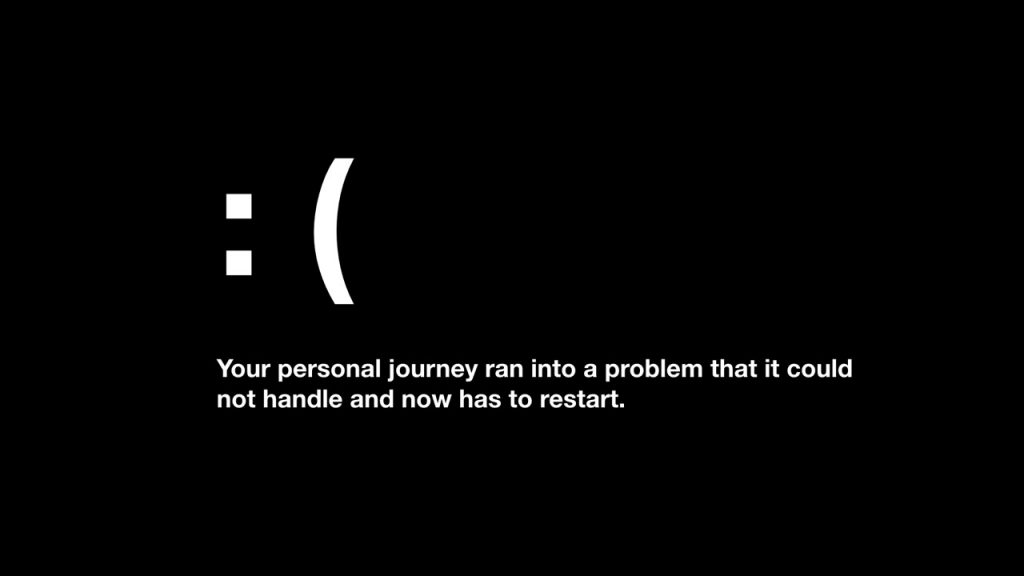
But like in every story, when you strive for something, the universe will push back. Punch you in the nose. Test you just to see how badly you really want it.
And the universe has gotten even better at it in the fictional world we live in today, especially with social media.
That “like” thumb is the opioid pusher of the web, addicting us with serotonin, dopamine and endorphins causing us to wear our happy masks even when we’re sad.
And of course there’s FOMO; the Fear of Missing Out as we become fawning voyeurs to others’ adventures.
Then we make the greatest personal narrative mistake: We compare what we think are our small stories to everyone else’s fictional epics. But what this really leads to is epic alienation and loneliness.
Look, we’re social human beings. Being connected to people is essential to our sanity and our survival. There’s nothing more fulfilling than feeling understood, appreciated and trusted by those who are close to us.
But what do we do to connect with others? We play roles in their lives, live into their stories to try to fit in; connect with them on their terms. But these roles are often inauthentic to who we really are.
The real problem when we’re living someone else’s story is that we:
- Lose confidence in ourselves as we try to measure up to their expectations.
- We don’t play to our strengths, weakening our impact.
- And we lose time toiling in fictional pursuits while our true journey waits for us in the wings.
We are so busy looking for the big stories to impress others that we don’t appreciate the small scenes that have made an impression on us… our unique moments that have shaped who we are today.
STEP 6: MENTOR – Describe how you are uniquely equipped to help them get what they want by sharing a truth you’ve come to understand
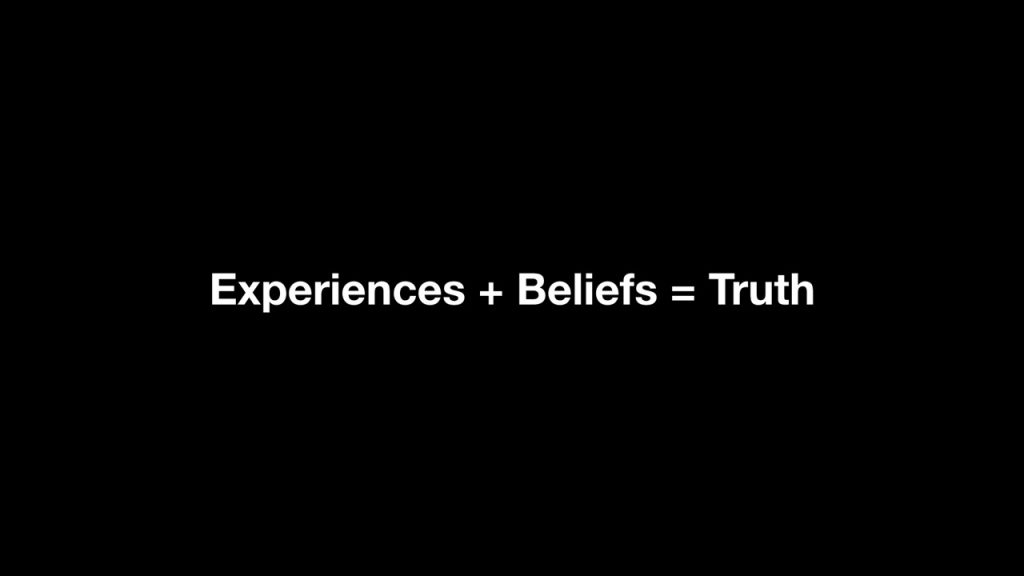
Believe me, I know the feeling. I woke up on Monday, September 14, 2015, with my stomach in knots. For the past 20 years, I had relentlessly built my advertising agency. I’d started out in a little shack behind our first house, grew, purchased a building, added lots of employees and created a business that I thought defined me.
I built a career I hoped my folks would be proud of, that my siblings would appreciate, that my peers would respect. But I wasn’t happy. Because I realized I wasn’t living into my story.
My answer was hiding in plain sight. In fact, I had been preaching and teaching it for five years.
As I mentioned, I was fascinated by storytelling, using it to craft brand story strategies to help our clients grow, and coaching leaders how to use it for themselves and their teams.
In fact, Arizona State University even asked me to create and teach a curriculum around my Story Cycle system for its Executive Masters of Sustainability Leadership program, which I did. What an honor.
The universe was now daring me to live into MY most powerful story: to consult, teach, coach and speak on how to use your unique, personal narrative to make your most profound impact in the world.
Which meant a career pivot…at 55. I thought, “Boy, this can either end in comedy or tragedy…although I was hoping for something greater.”
Because here’s the truth I knew, but then had to learn for myself:
Compelling storytelling is ALWAYS about the moments. Those scenes are composed of your experiences that define your beliefs, which lead to your truth. When you unwrap your truth you find your superpower to nudge the world in any direction you choose.
STEP 7: JOURNEY – Here’s the specific action you ask your audience to take despite all odds
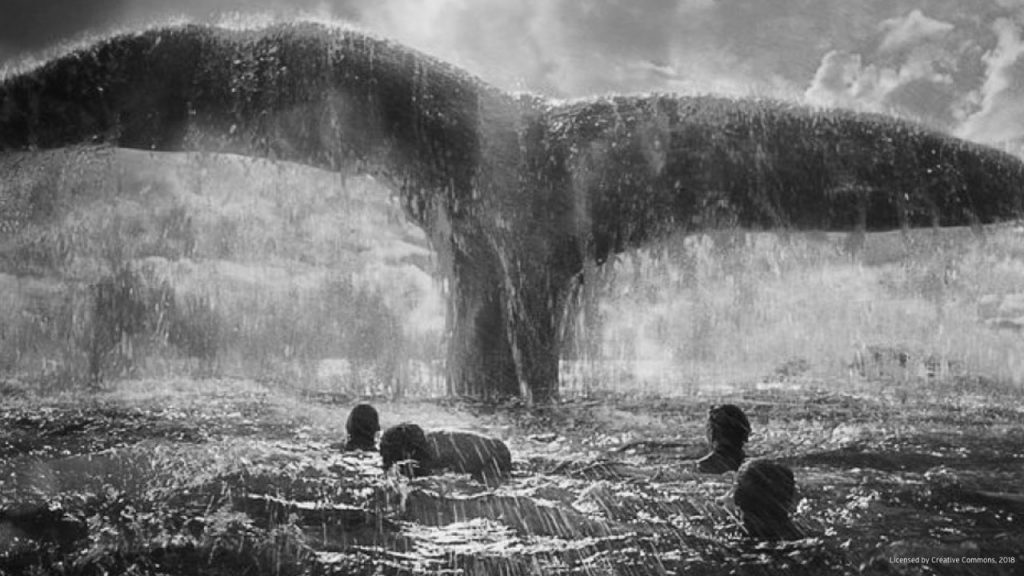
But here’s the toughest part of this story/scene thing: Hollywood calls it “The Dark Night of the Soul.” I prefer “The Belly of the Whale.” I know someone who might call it, “The Ukrainian Orphanage.”
It is in these moments of struggle when the universe is putting the screws to you and your character, where you’ll find the pivotal scenes that propel your story forward.
But, like an anthropologist, you have to dig ‘em up. They’re typically buried under the detritus of life, scrubbed from your immediate recall due to their unpleasantness, or hidden beneath the pile of scripts others think you should be playing to.
Picture one evening, a nine-year-old boy named James is in the kitchen with his aunt. While she’s enjoying her tea, James stands at the stove by a boiling teapot.
He’s fascinated by the steam coming out of the spout. So much so that he holds a silver spoon over the jet stream and watches as drops of water form on the spoon and run down the handle, marveling at this simple phenomenon.
His aunt is pissed… thinks he’s lazy. She barks at him to go read a book or do something useful for a change.
“Aren’t you embarrassed for yourself?” she scolds.
Imagine how James felt.
Fortunately for us, the boy was undaunted. Two decades later, in 1765, the then 29-year-old James Watt invented a new kind of steam engine that helped usher in the Industrial Revolution.
His teapot scene led to a marvelous journey that impacted all of humanity. And when you think of marvelous journeys, what TED Talk would be complete without channeling Steve Jobs? His iconic odyssey started in seemingly insignificant moments, too.
Like when his parents admonished him for wasting time studying calligraphy at Reed College in Oregon. Ah, but what did his fascination produce? The graphical interface that launched Apple and revolutionized our computing world.
STEP 8: VICTORY – Provide hope by describing what success looks like as you re-iterate your theme

You see, even revolutions begin in moments of discovery and inspiration. So stop looking for your stories and start finding your scenes.
STEP 9: MORAL – Reveal the truth you have found that is the pathway to their success
When you own your unique moments, wonderful things happen. You will…

Clarify your fundamental origin story that will help people understand who you are and where you are going.

You amplify your impact with your personal narrative by enabling others to experience what you experienced, connecting your shared beliefs and values, which builds trust.

And living into your authentic story simplifies your life by you just being you.
STEP 10: RITUAL – Connect your story to their story with a specific call-to-action
So how DO you find your scenes and live into your most powerful story? Before you go to bed tonight, jot down three moments that have shaped who you are today. Simply start by writing “That time when”…
- That time when something suddenly piqued your curiosity and you had to dive into it headlong.
- That time when a seemingly insignificant moment surprisingly became a major turning point for you.
- That time when you did something you thought you couldn’t.
What was YOUR enlightening “Calligraphy moment”?
YOUR curious “Teapot incident”?
YOUR episode of feeling lost and abandoned?
Or, as with my mom, Nurse Howell, what is that symbolic orange that inspired your purpose?
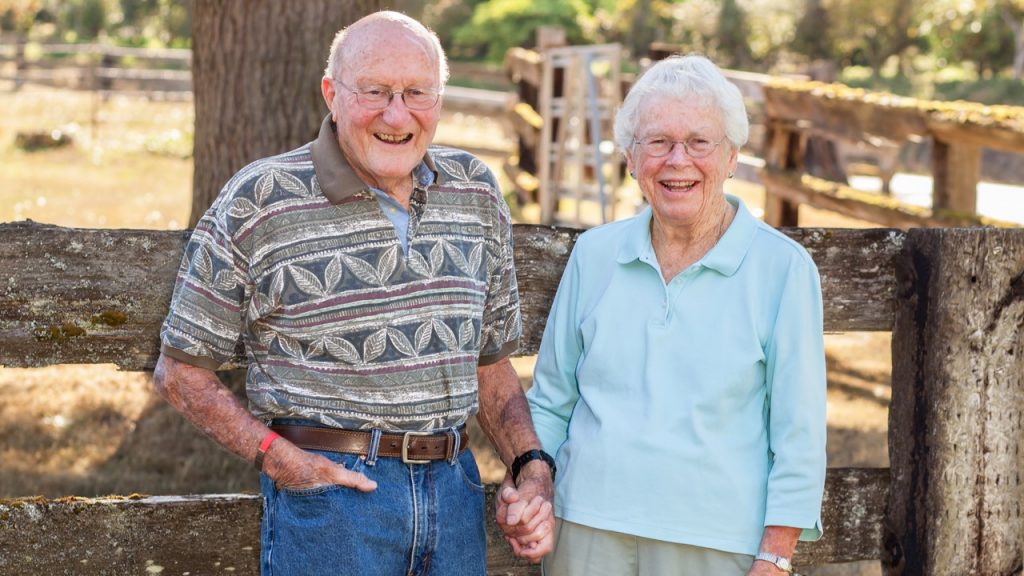
In the morning, start stringing those scenes together. You might even get a little pit in your stomach as YOUR true calling awakens within you. I promise you’ll learn as I did that…
The most potent story you will ever tell is the story you tell yourself. So make it a great one.
Story on, my friends.
The 3-step TEDxGilbert story exercise for your team
Do you want to build more camaraderie within your team? Many of my clients are doing the following with my TEDx Talk:
- Gather your team and watch the video
- Have them spend that evening away from the office finding the scenes that have shaped who they are today and why they do what they do for you and your organization
- Gather again the next morning and have each team member share their story in under two minutes about a moment that shaped who they are today
This simple story exercise creates understanding for what fellow team members are about. It helps people appreciate what others are going through. And it creates empathy that builds trust.
Clarifying your stories also helps you get focused on who you are and where you’re going. And if for whatever reason you or some of your people sour on your current situation in life, it’s simply because you are not yet living into your most potent story.
Think of this story exercise as your lemon drop to create a personal narrative you’ll salivate over.




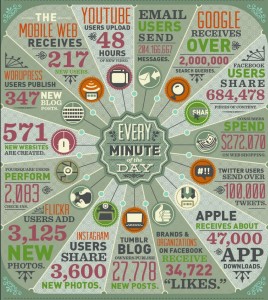

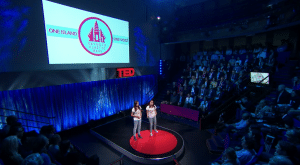





at 8:13 am
Park! I love this post!! I appreciate the comparison that your dentist can’t do his own root canal so likewise even you needed help crafting your story. You did an amazing job on your TEDxGilbert talk! Thanks for sharing your great ideas.
at 12:41 pm
[…] First, get clear on what your origin story is, not by looking for some epic story, but by finding your scenes: those elemental moments that have shaped who you are today. Find your scenes and your story will find you. Watch my TEDxGilbert Talk and I’ll show you how. […]